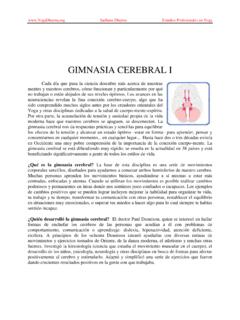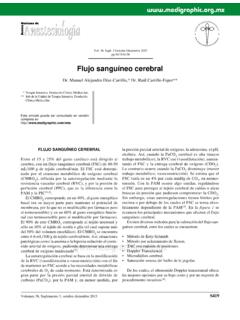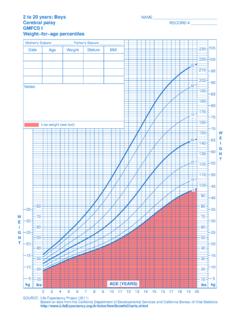Transcription of Manual Ability Classification System for Children …
1 Information for usersThe Manual Ability Classification System (MACS) describes how Children with cerebralpalsy (CP) use their hands to handle objects in daily activities. MACS describes fivelevels. The levels are based on the Children s self-initiated Ability to handle objects andtheirneed forassistance oradaptation toperform Manual activities in everydaylife. TheppyyMACS brochure also describes differences between adjacent levels to make it easier todetermine which level best corresponds with the child s Ability to handle objects referred to are those that are relevant and age-appropriate for the Children ,used when they perform tasks such as eating, dressing, playing, drawing or writing. It isobjects that are within the Children s personal space that is referred to, as oppose toobjects that are beyond their reach. Objects used in advanced activities that requireilkillhliitttilddithiidtispecials kills, suchas playing aninstrumentare notincludedinthis establishing a child s MACS level, choose the level that best describes the child soverall usual performance, in the home, school or community setting.
2 The child smotivation and cognitive Ability also affect the Ability to handle objects and accordinglyinfluence the MACS level. In order to obtain knowledge about how a child handlesvarious everyday objects it is necessary to ask someone who knows the child Ability Classification System for Children with cerebral Palsy MACS isintendedtoclassifywhatthechildrenusual lydo,nottheirbestpossibleperformance in a specific test is a functional description that can be used in a way that is complement to thediagnosis of cerebral palsy and its subtypes. MACS assesses the Children s overallability to handle everyday objects, not the function of each hand separately. MACS doesnot take into account differences in function between the two hands; rather, it addresseshow the Children handle age-appropriate objects. MACS does not intend to explain the4-18 yearsunderlying reasons for impaired Manual can be used for Children aged 4 18 years, but certain concepts must be placedin relation to the child s age.
3 Naturally there is a difference in which objects a four-yearold should be able to handle, compared with a teenager. The same applies toindependence a young child needs more help and supervision than an older spans the entire spectrum of functionallimitations found among Children withcerebral palsy and covers all sub-diagnoses. Certain sub-diagnoses can be found at allMACS levels, such as bilateral CP, while others are found at fewer levels, such asunilateral CP. Level I includes Children with minor limitations, while Children with severefunctional limitations will usually be found at levels IV and V. If typically developedchildren were to be classified according to MACS, however, a level 0 would lidftiItilik lth tMACS classifies how Children with cerebral palsy use their hands to handle objects in daily activities. MACS describes how Children usually use their hands to handle objects in the home, school, and community settings (what they do), rather than what is known to be their best capacity.
4 Moreover, eachlevelincludes Children is sensitive to changes after an intervention; in all probability, MACS levels arestable over five levels in MACS form an ordinal scale, which means that the levels are ordered but differences between levels are not necessarily equal, nor are Children with cerebralpalsy equally distributed across the five :annchristineliasson@kise;wwwmacsnu In order to obtain knowledge about how a child handles various everyday objects, it is necessary to ask someone who knows the child well, rather than through a specific test. The objects the child handles should be considered from an age-related perspective. MACS classify a child s overall Ability to handle objects not each AC, Krumlinde Sundholm L, R sblad B, Beckung E, Arner M, hrvall AM , Rosenbaum P. The ManualAbility Classification System (MACS) for Children with cerebral palsy: scale development and evidence of validityand reliability Developmental Medicine and Child Neurology 2006 48:549-554 MACS classify a child s overall Ability to handle objects, not each hand separately.
5 2005, updated 2010 Distinctions between Levels I and IIChildren in Level I may have limitations in handling very small, heavy or fragile objects which demand detailed fine motor control, or efficient coordination between hands. Limitations may also involve performance in new and What do you need to know to use MACS?The child's Ability to handle objects in important daily activities, for example during play and leisure, eating and dressing. unfamiliar situations. Children in Level II perform almost the same activities as Children in Level I but the quality of performance is decreased, or the performance is slower. Functional differences between hands can limit effectiveness of performance. Children in Level II commonly try to simplify handling of objects, for example by using a surface for support instead of handling objects with both objects easily and most,li it tiithffiltkiidIn which situation is the child independent and to what extent do they need support and adaptation?
6 Limitationsinthe ease ofperforming manualtasks requiring speedand accuracy. However, any limitations in Manual abilities do notrestrict independence in daily most objects but with somewhat reducedquality and/or speed of activitiesmaybeavoidedorbeachievedwithso medifficulty;alternativewaysDistinctions between Levels II and IIIC hildren in Level II handle most objects, although slowly or with reduced quality of performance. Children in Level III commonly need help to prepare the activity d/idj tt t bd t thit ith ibilit tmaybeavoidedorbeachievedwithsomedifficu lty;alternativewaysof performance might be used but Manual abilities do not usuallyrestrict independence in daily objects with difficulty; needs help toprepare and/or modify performance is slowand achieved with limited success regardingqualityand require adjustments to be made to the environment since their Ability to reach or handle objects is limited. They cannot perform certain activities and their degree of independence is related to the supportiveness of the environmental context.
7 GgyyActivities are performed independently if they have been set up a limited selection of easily managedobjects in adapted parts of activitieswith effort and with limited success. Requires continuous supportditd/dtditfti lDistinctions between Levels III and IVChildren in Level III can perform selected activities if the situation is prearranged and if they get supervision and plenty of time. Children in Level IV need continuous help during the activity and can at best participate meaningfully in only parts of an and/or adaptedequipment,for even partialachievement of the not handle objects and has severely limitedability to perform even simple between Levels IV and VChildren in Level IV perform part of an activity, however, they need help continuously. Children in Level V might at best participate with a simple movement in special situations, by pushing a button or occasionally hold undemanding objects.







